Professional Practice Taxation: Analyzing Tax Liabilities Report
VerifiedAdded on 2020/03/16
|9
|1485
|37
Report
AI Summary
This report provides a detailed analysis of professional practice taxation, focusing on the computation of taxable income for Jordan and Cameron. It meticulously calculates their assessable income, considering various sources like salary, rental income, and interest. The report then outlines allowable deductions, including interest payments, work-related expenses, and tax agent fees, to arrive at their taxable income. It also considers specific tax offsets and levies, such as Medicare levy and superannuation tax offsets, to determine the total tax payable. The report also addresses the tax implications for Cate, Jordan's daughter, who is employed part-time, considering the relevant tax rulings for minors. It computes Cate's tax liability based on her assessable income and applicable tax offsets. The report references relevant case law and taxation rulings to support its conclusions, providing a comprehensive overview of the tax assessment process and tax liability for each individual.

Running head: PROFESSIONAL PRACTICE TAXATION
Professional Practice Taxation
Name of the Student
Name of the University
Authors Note
Course ID
Professional Practice Taxation
Name of the Student
Name of the University
Authors Note
Course ID
Paraphrase This Document
Need a fresh take? Get an instant paraphrase of this document with our AI Paraphraser
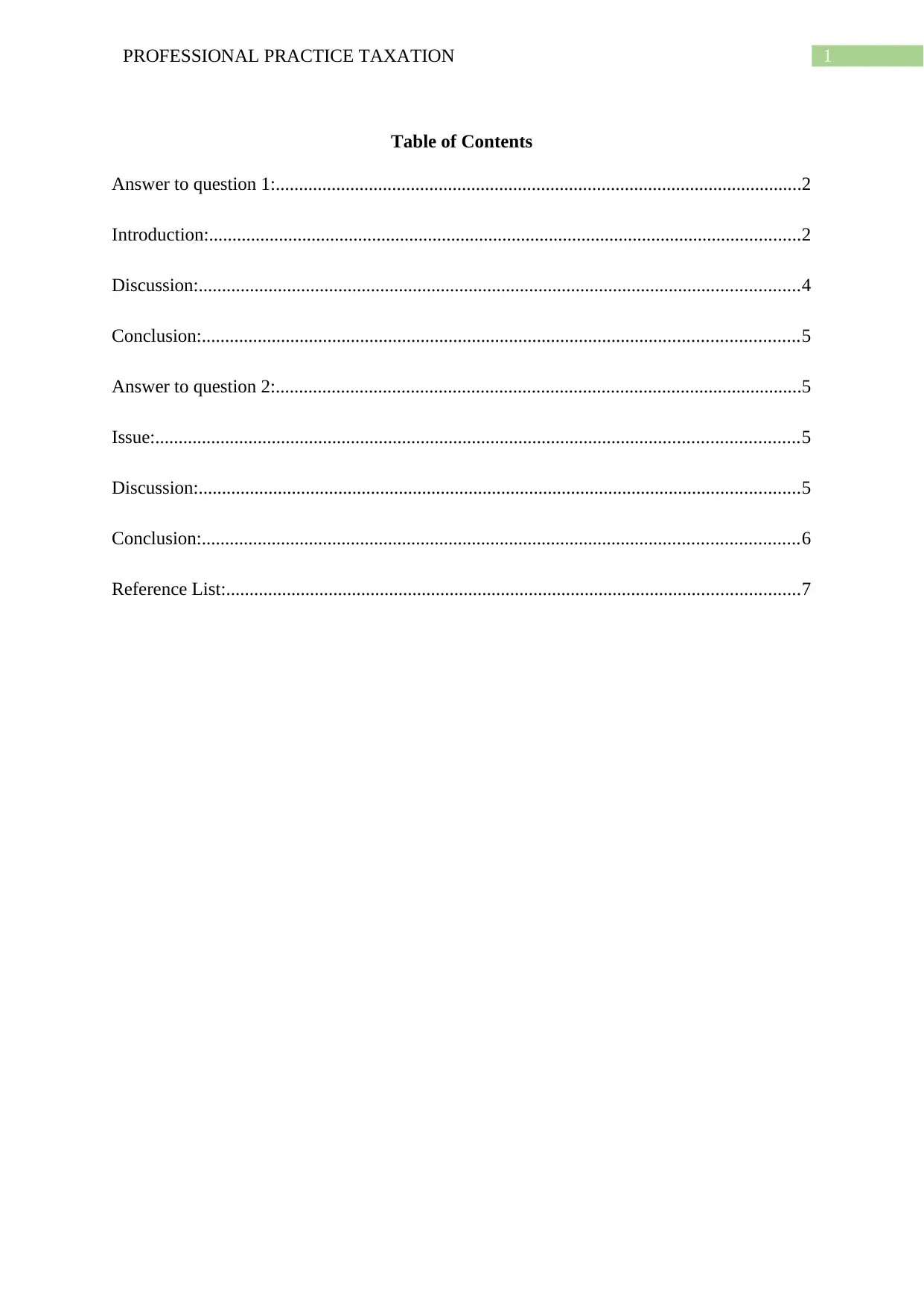
1PROFESSIONAL PRACTICE TAXATION
Table of Contents
Answer to question 1:.................................................................................................................2
Introduction:...............................................................................................................................2
Discussion:.................................................................................................................................4
Conclusion:................................................................................................................................5
Answer to question 2:.................................................................................................................5
Issue:..........................................................................................................................................5
Discussion:.................................................................................................................................5
Conclusion:................................................................................................................................6
Reference List:...........................................................................................................................7
Table of Contents
Answer to question 1:.................................................................................................................2
Introduction:...............................................................................................................................2
Discussion:.................................................................................................................................4
Conclusion:................................................................................................................................5
Answer to question 2:.................................................................................................................5
Issue:..........................................................................................................................................5
Discussion:.................................................................................................................................5
Conclusion:................................................................................................................................6
Reference List:...........................................................................................................................7

2PROFESSIONAL PRACTICE TAXATION
Answer to question 1:
Introduction:
The current study is based on the determination of the taxable income of Jordan and
Cameron. The study will take into the considerations the amount of tax payable by Jordan
and Cameron from their respective transactions. The study will additionally lay down the
assumptions for considering and omitting the expenditure at the time of computing the tax
liability.
Computation of Taxable Income of Jordan
Computation of Taxable Income of Jordan
Particulars Amount ($) Amount ($)
Assessable Income
Gross Salary 180000
Add: PayG 58000 238000
Australian Sourced Rental Income (Jordan Share)
Rental Income from Holiday House (Jordan Share) 2000
Investment property Rental Income (Jordan Share) 11000
Australian Sourced Interest Income
Bank Account (Jordan Share) 1000
Superannuation Jordan 80000
Total Assessable Income 332000
Allowable Deductions
Interest paid on mortgage home 12000
Interest paid on investment property 23333
Interest paid on holiday house 13333
Work Related Expenditure 2200
Expenses on holiday homes 6250
Tax Agent Fees 900
Expenses on investment property 7500
Total Allowable Deductions 65517
Total Taxable Income 266483
Tax on Taxable Income 93149
Add: Medicare Levy 5330
Less: PayG 58000
Add: Taxable Value of Fringe Benefit Car 4000
Answer to question 1:
Introduction:
The current study is based on the determination of the taxable income of Jordan and
Cameron. The study will take into the considerations the amount of tax payable by Jordan
and Cameron from their respective transactions. The study will additionally lay down the
assumptions for considering and omitting the expenditure at the time of computing the tax
liability.
Computation of Taxable Income of Jordan
Computation of Taxable Income of Jordan
Particulars Amount ($) Amount ($)
Assessable Income
Gross Salary 180000
Add: PayG 58000 238000
Australian Sourced Rental Income (Jordan Share)
Rental Income from Holiday House (Jordan Share) 2000
Investment property Rental Income (Jordan Share) 11000
Australian Sourced Interest Income
Bank Account (Jordan Share) 1000
Superannuation Jordan 80000
Total Assessable Income 332000
Allowable Deductions
Interest paid on mortgage home 12000
Interest paid on investment property 23333
Interest paid on holiday house 13333
Work Related Expenditure 2200
Expenses on holiday homes 6250
Tax Agent Fees 900
Expenses on investment property 7500
Total Allowable Deductions 65517
Total Taxable Income 266483
Tax on Taxable Income 93149
Add: Medicare Levy 5330
Less: PayG 58000
Add: Taxable Value of Fringe Benefit Car 4000
⊘ This is a preview!⊘
Do you want full access?
Subscribe today to unlock all pages.

Trusted by 1+ million students worldwide
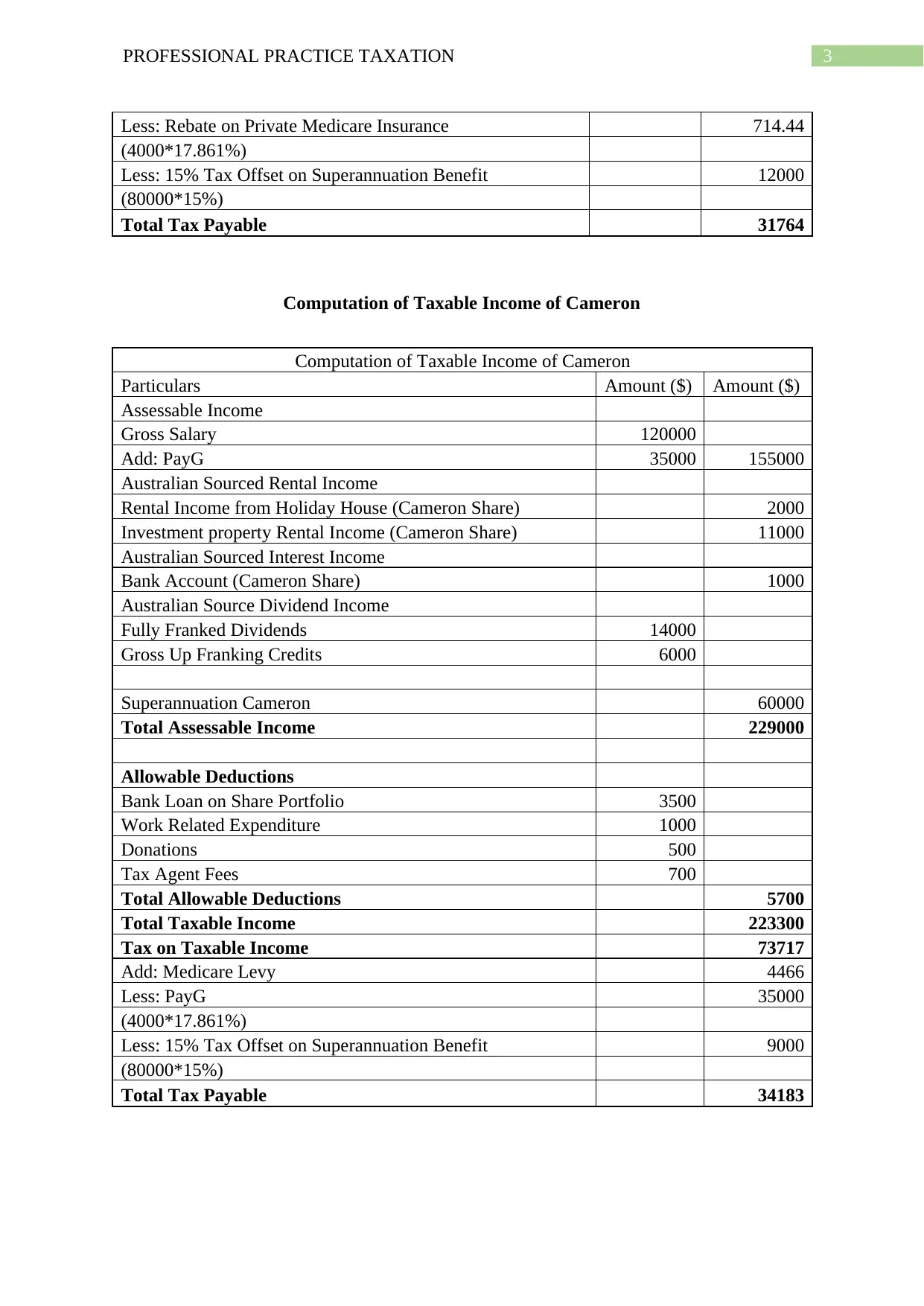
3PROFESSIONAL PRACTICE TAXATION
Less: Rebate on Private Medicare Insurance 714.44
(4000*17.861%)
Less: 15% Tax Offset on Superannuation Benefit 12000
(80000*15%)
Total Tax Payable 31764
Computation of Taxable Income of Cameron
Computation of Taxable Income of Cameron
Particulars Amount ($) Amount ($)
Assessable Income
Gross Salary 120000
Add: PayG 35000 155000
Australian Sourced Rental Income
Rental Income from Holiday House (Cameron Share) 2000
Investment property Rental Income (Cameron Share) 11000
Australian Sourced Interest Income
Bank Account (Cameron Share) 1000
Australian Source Dividend Income
Fully Franked Dividends 14000
Gross Up Franking Credits 6000
Superannuation Cameron 60000
Total Assessable Income 229000
Allowable Deductions
Bank Loan on Share Portfolio 3500
Work Related Expenditure 1000
Donations 500
Tax Agent Fees 700
Total Allowable Deductions 5700
Total Taxable Income 223300
Tax on Taxable Income 73717
Add: Medicare Levy 4466
Less: PayG 35000
(4000*17.861%)
Less: 15% Tax Offset on Superannuation Benefit 9000
(80000*15%)
Total Tax Payable 34183
Less: Rebate on Private Medicare Insurance 714.44
(4000*17.861%)
Less: 15% Tax Offset on Superannuation Benefit 12000
(80000*15%)
Total Tax Payable 31764
Computation of Taxable Income of Cameron
Computation of Taxable Income of Cameron
Particulars Amount ($) Amount ($)
Assessable Income
Gross Salary 120000
Add: PayG 35000 155000
Australian Sourced Rental Income
Rental Income from Holiday House (Cameron Share) 2000
Investment property Rental Income (Cameron Share) 11000
Australian Sourced Interest Income
Bank Account (Cameron Share) 1000
Australian Source Dividend Income
Fully Franked Dividends 14000
Gross Up Franking Credits 6000
Superannuation Cameron 60000
Total Assessable Income 229000
Allowable Deductions
Bank Loan on Share Portfolio 3500
Work Related Expenditure 1000
Donations 500
Tax Agent Fees 700
Total Allowable Deductions 5700
Total Taxable Income 223300
Tax on Taxable Income 73717
Add: Medicare Levy 4466
Less: PayG 35000
(4000*17.861%)
Less: 15% Tax Offset on Superannuation Benefit 9000
(80000*15%)
Total Tax Payable 34183
Paraphrase This Document
Need a fresh take? Get an instant paraphrase of this document with our AI Paraphraser
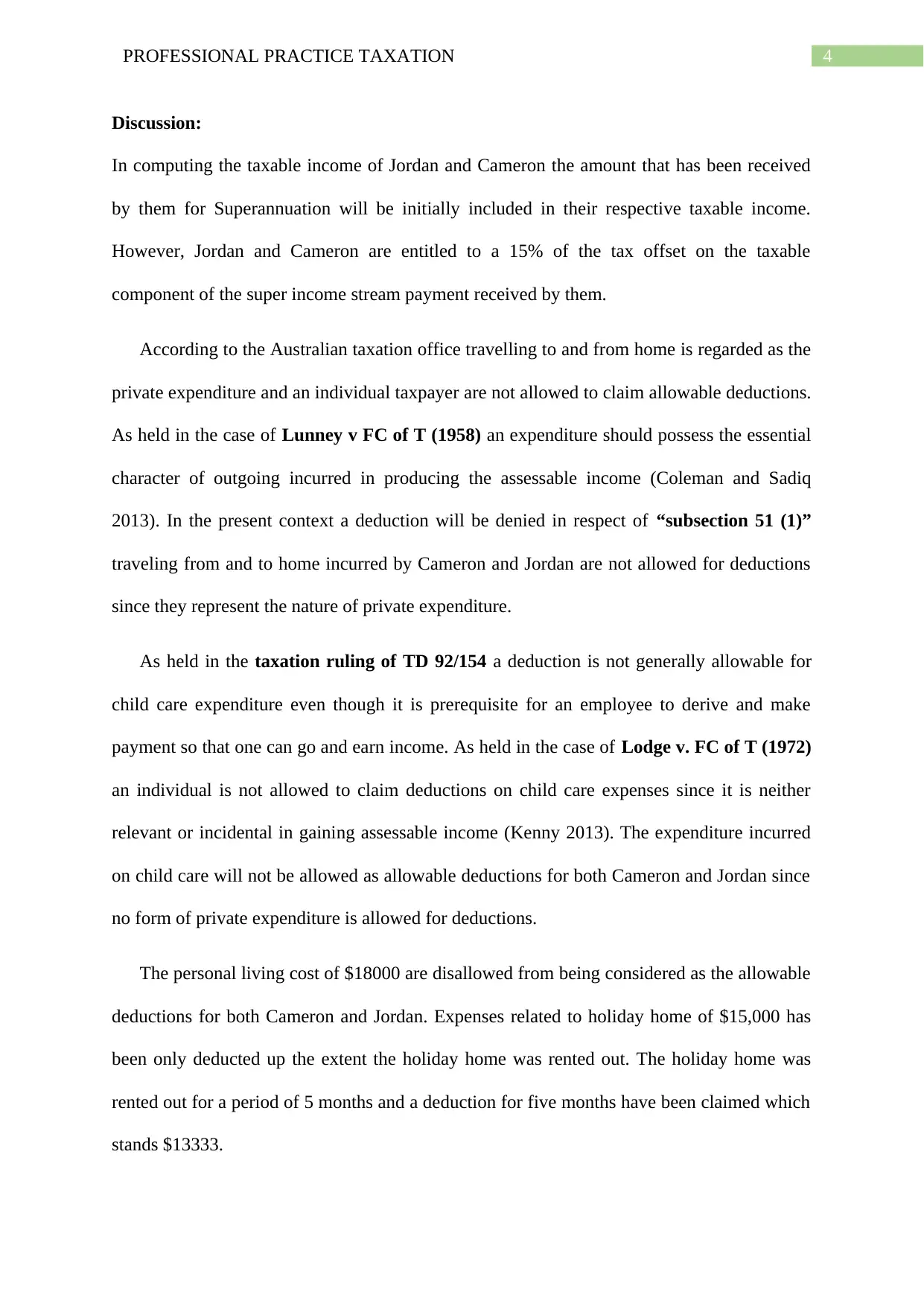
4PROFESSIONAL PRACTICE TAXATION
Discussion:
In computing the taxable income of Jordan and Cameron the amount that has been received
by them for Superannuation will be initially included in their respective taxable income.
However, Jordan and Cameron are entitled to a 15% of the tax offset on the taxable
component of the super income stream payment received by them.
According to the Australian taxation office travelling to and from home is regarded as the
private expenditure and an individual taxpayer are not allowed to claim allowable deductions.
As held in the case of Lunney v FC of T (1958) an expenditure should possess the essential
character of outgoing incurred in producing the assessable income (Coleman and Sadiq
2013). In the present context a deduction will be denied in respect of “subsection 51 (1)”
traveling from and to home incurred by Cameron and Jordan are not allowed for deductions
since they represent the nature of private expenditure.
As held in the taxation ruling of TD 92/154 a deduction is not generally allowable for
child care expenditure even though it is prerequisite for an employee to derive and make
payment so that one can go and earn income. As held in the case of Lodge v. FC of T (1972)
an individual is not allowed to claim deductions on child care expenses since it is neither
relevant or incidental in gaining assessable income (Kenny 2013). The expenditure incurred
on child care will not be allowed as allowable deductions for both Cameron and Jordan since
no form of private expenditure is allowed for deductions.
The personal living cost of $18000 are disallowed from being considered as the allowable
deductions for both Cameron and Jordan. Expenses related to holiday home of $15,000 has
been only deducted up the extent the holiday home was rented out. The holiday home was
rented out for a period of 5 months and a deduction for five months have been claimed which
stands $13333.
Discussion:
In computing the taxable income of Jordan and Cameron the amount that has been received
by them for Superannuation will be initially included in their respective taxable income.
However, Jordan and Cameron are entitled to a 15% of the tax offset on the taxable
component of the super income stream payment received by them.
According to the Australian taxation office travelling to and from home is regarded as the
private expenditure and an individual taxpayer are not allowed to claim allowable deductions.
As held in the case of Lunney v FC of T (1958) an expenditure should possess the essential
character of outgoing incurred in producing the assessable income (Coleman and Sadiq
2013). In the present context a deduction will be denied in respect of “subsection 51 (1)”
traveling from and to home incurred by Cameron and Jordan are not allowed for deductions
since they represent the nature of private expenditure.
As held in the taxation ruling of TD 92/154 a deduction is not generally allowable for
child care expenditure even though it is prerequisite for an employee to derive and make
payment so that one can go and earn income. As held in the case of Lodge v. FC of T (1972)
an individual is not allowed to claim deductions on child care expenses since it is neither
relevant or incidental in gaining assessable income (Kenny 2013). The expenditure incurred
on child care will not be allowed as allowable deductions for both Cameron and Jordan since
no form of private expenditure is allowed for deductions.
The personal living cost of $18000 are disallowed from being considered as the allowable
deductions for both Cameron and Jordan. Expenses related to holiday home of $15,000 has
been only deducted up the extent the holiday home was rented out. The holiday home was
rented out for a period of 5 months and a deduction for five months have been claimed which
stands $13333.

5PROFESSIONAL PRACTICE TAXATION
Expenses on investment property is also rented out for only 10 months and as result of
this the expenditure incurred has been apportioned for a period of 10 months only with an
approximate value of $23333. The capital loss bought forward by Cameron of $7,000 cannot
be allowed for offset since Cameron did not reported any Capital gains. Hence, such losses
can be offset only against capital gains.
According to the Australian Taxation Office credit card, expenditure can be claimed as
allowable deductions only for paying the business tax liability (Krever 2013). In the present
context, the credit card expenditure will not be allowed as allowable deductions since the
expenditure was not used for business purpose and deductions are not allowed for this
purpose.
Conclusion:
The above stated discussion effectively lay down that the net amount of tax payable
by both Jordan and Cameron respectively. Additionally, relative sections and legislations
have been considered in arriving at net tax payable by them.
Answer to question 2:
Issue:
The present issue is concerned with the determination of the tax assessment of the
assessable income of the minors under the age of 18 that are not engaged in the full time
employment.
Discussion:
The income tax ruling of IT 2489 is applicable to the unmarried children that are
under the age of 18 and are engaged in the full time employment are liable to pay tax for their
income. Division 6AA of the part III of the ITAA 1997 defines that an individual at the age
Expenses on investment property is also rented out for only 10 months and as result of
this the expenditure incurred has been apportioned for a period of 10 months only with an
approximate value of $23333. The capital loss bought forward by Cameron of $7,000 cannot
be allowed for offset since Cameron did not reported any Capital gains. Hence, such losses
can be offset only against capital gains.
According to the Australian Taxation Office credit card, expenditure can be claimed as
allowable deductions only for paying the business tax liability (Krever 2013). In the present
context, the credit card expenditure will not be allowed as allowable deductions since the
expenditure was not used for business purpose and deductions are not allowed for this
purpose.
Conclusion:
The above stated discussion effectively lay down that the net amount of tax payable
by both Jordan and Cameron respectively. Additionally, relative sections and legislations
have been considered in arriving at net tax payable by them.
Answer to question 2:
Issue:
The present issue is concerned with the determination of the tax assessment of the
assessable income of the minors under the age of 18 that are not engaged in the full time
employment.
Discussion:
The income tax ruling of IT 2489 is applicable to the unmarried children that are
under the age of 18 and are engaged in the full time employment are liable to pay tax for their
income. Division 6AA of the part III of the ITAA 1997 defines that an individual at the age
⊘ This is a preview!⊘
Do you want full access?
Subscribe today to unlock all pages.

Trusted by 1+ million students worldwide

6PROFESSIONAL PRACTICE TAXATION
of 18 years might be taxed at the rate higher than the adult (Morgan, Mortimer and Pinto
2013).
As evident from the current case study it can be defined that Jordan employed his
younger daughter Cate to carry out the administrative work for him as the personal assistant.
As defined under the Division 6AA all the types of assessable income are eligible for tax
unless the income of the minor falls inside the purview of the excepted assessable income
under the subsection 102AE (2) (Woellner 2013). Additionally, the extent to which the
minor had effective conduct and control and effectively participated in the functions of the
taxpayer’s business or employment.
As understood from the current context the receipt of employment income in the
hands of Cate would ultimately help in reducing the tax liability of Jordan but may attract a
liability to tax for Cate (Woellner et al. 2014). It is assumed that Cate is under the age of 18
and under the division 6AA Cate will be liable for tax for the amount of income received
from her part time employment.
Computation of Tax Liability for Cate
Particulars Amount ($) Amount ($)
Assessable Income 20800
Tax on Taxable Income 494
Low Income Tax Offset 445
Total Tax Payable 49
Conclusion:
The above stated discussion can be concluded by stating that the income received
from the part time employment will be regarded as taxable income for Cate which will attract
tax liability.
of 18 years might be taxed at the rate higher than the adult (Morgan, Mortimer and Pinto
2013).
As evident from the current case study it can be defined that Jordan employed his
younger daughter Cate to carry out the administrative work for him as the personal assistant.
As defined under the Division 6AA all the types of assessable income are eligible for tax
unless the income of the minor falls inside the purview of the excepted assessable income
under the subsection 102AE (2) (Woellner 2013). Additionally, the extent to which the
minor had effective conduct and control and effectively participated in the functions of the
taxpayer’s business or employment.
As understood from the current context the receipt of employment income in the
hands of Cate would ultimately help in reducing the tax liability of Jordan but may attract a
liability to tax for Cate (Woellner et al. 2014). It is assumed that Cate is under the age of 18
and under the division 6AA Cate will be liable for tax for the amount of income received
from her part time employment.
Computation of Tax Liability for Cate
Particulars Amount ($) Amount ($)
Assessable Income 20800
Tax on Taxable Income 494
Low Income Tax Offset 445
Total Tax Payable 49
Conclusion:
The above stated discussion can be concluded by stating that the income received
from the part time employment will be regarded as taxable income for Cate which will attract
tax liability.
Paraphrase This Document
Need a fresh take? Get an instant paraphrase of this document with our AI Paraphraser
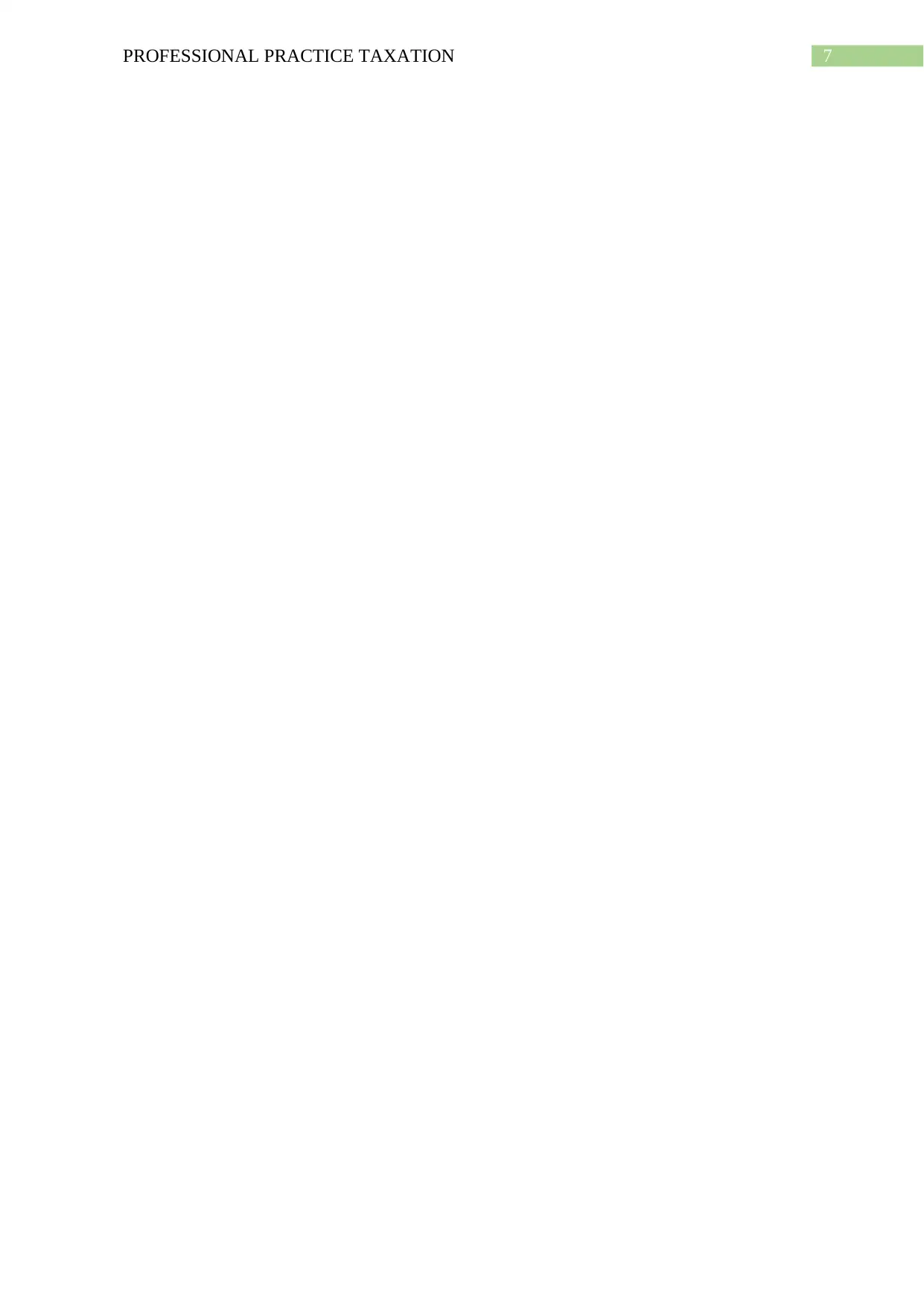
7PROFESSIONAL PRACTICE TAXATION
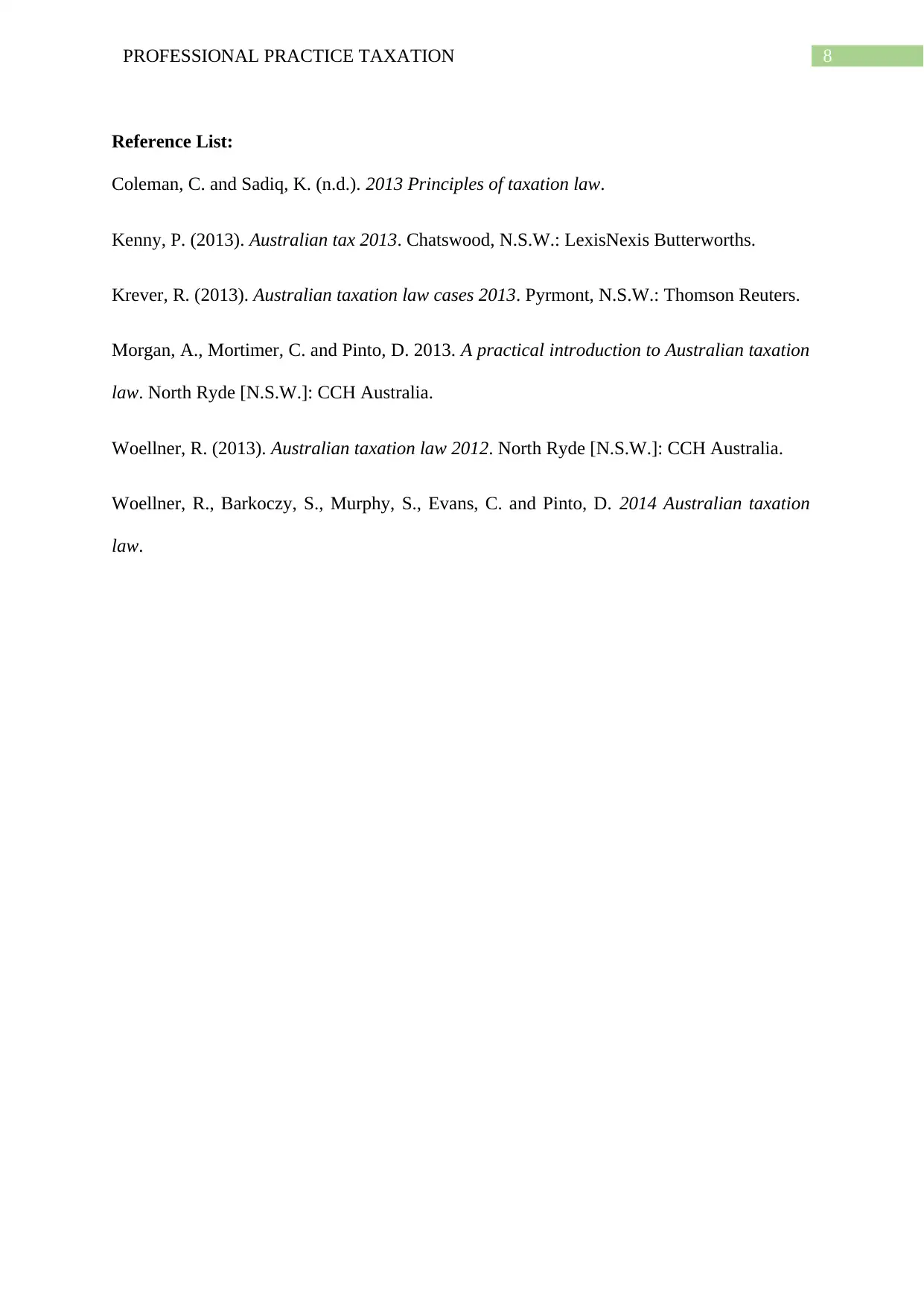
8PROFESSIONAL PRACTICE TAXATION
Reference List:
Coleman, C. and Sadiq, K. (n.d.). 2013 Principles of taxation law.
Kenny, P. (2013). Australian tax 2013. Chatswood, N.S.W.: LexisNexis Butterworths.
Krever, R. (2013). Australian taxation law cases 2013. Pyrmont, N.S.W.: Thomson Reuters.
Morgan, A., Mortimer, C. and Pinto, D. 2013. A practical introduction to Australian taxation
law. North Ryde [N.S.W.]: CCH Australia.
Woellner, R. (2013). Australian taxation law 2012. North Ryde [N.S.W.]: CCH Australia.
Woellner, R., Barkoczy, S., Murphy, S., Evans, C. and Pinto, D. 2014 Australian taxation
law.
Reference List:
Coleman, C. and Sadiq, K. (n.d.). 2013 Principles of taxation law.
Kenny, P. (2013). Australian tax 2013. Chatswood, N.S.W.: LexisNexis Butterworths.
Krever, R. (2013). Australian taxation law cases 2013. Pyrmont, N.S.W.: Thomson Reuters.
Morgan, A., Mortimer, C. and Pinto, D. 2013. A practical introduction to Australian taxation
law. North Ryde [N.S.W.]: CCH Australia.
Woellner, R. (2013). Australian taxation law 2012. North Ryde [N.S.W.]: CCH Australia.
Woellner, R., Barkoczy, S., Murphy, S., Evans, C. and Pinto, D. 2014 Australian taxation
law.
⊘ This is a preview!⊘
Do you want full access?
Subscribe today to unlock all pages.

Trusted by 1+ million students worldwide
1 out of 9
Related Documents
Your All-in-One AI-Powered Toolkit for Academic Success.
+13062052269
info@desklib.com
Available 24*7 on WhatsApp / Email
![[object Object]](/_next/static/media/star-bottom.7253800d.svg)
Unlock your academic potential
Copyright © 2020–2025 A2Z Services. All Rights Reserved. Developed and managed by ZUCOL.




